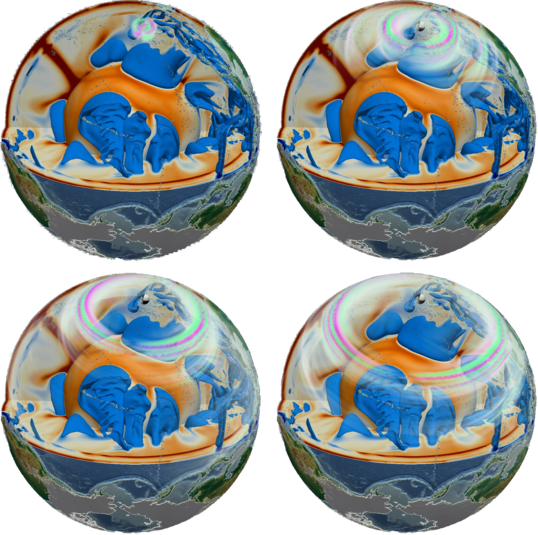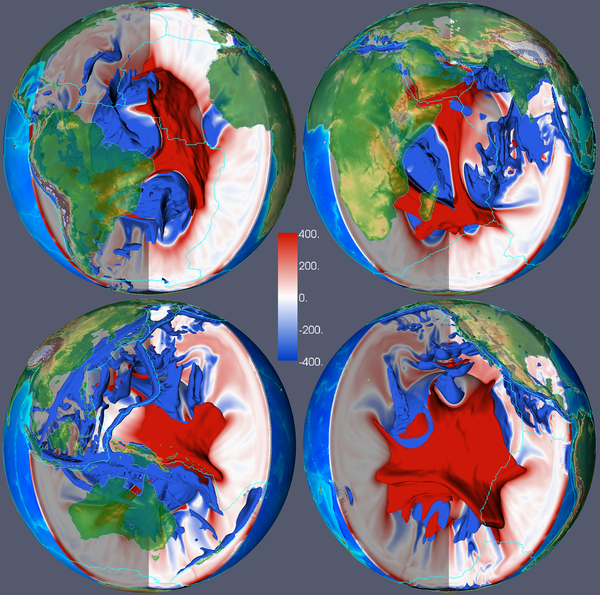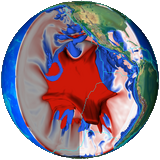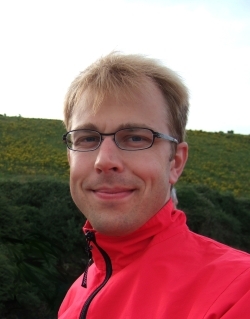Research Interests
My research is focused on a multidisciplinary approach combining computational seismology, geodynamics and mineral physics, which aims at a better understanding of deep Earth structure and dynamics. I have addressed problems regarding the accuracy of numerical methods for 3-D seismic wave propagation, the generation of synthetic models of mantle heterogeneity based on dynamic flow calculations (see Fig. 2), and the analysis of their thermal and elastic signature as well as a quantitative assessment of their seismic expressions against tomography. Recently, I have set up a novel joint forward modeling framework that can serve as a complementary tool to tomographic inversions: geodynamically derived models of seismic mantle structure are used in simulations of global wave propagation (Fig. 1). This way, specific hypotheses on mantle dynamics can be tested directly against seismic data.

Figure 1. Snapshots of the three-dimensional wavefield in one of our geodynamic models. 3-D global wave propagation was simulated for an earthquake in the Fiji Islands region using a spectral element technique. The wavefield is depicted by green and magenta colours together with the shear wave velocity variations in the model, for which vertical cross-sections and iso-surfaces are shown on a blue to brownish colour scale ranging from -2 to 2 per cent. Surface topography is also shown for parts of the globe for geographic reference [Schuberth et al. 2012].
Methods and tools involved:
i.e., Multiplication with the resolution operator to mimic the effects of uneven data coverage and damping in tomographic inversions
Details
Long-standing questions in the study of Earth's deep interior are about the origin of seismic heterogeneity and the nature of flow in the mantle. Understanding the dynamic behavior is important as the flow drives plate tectonics and controls the way the Earth looses its heat. Thus, it is a crucial factor in tectonic modeling or in simulations of the geodynamo and of the thermal history of the Earth. A better understanding of these aspects is of great societal importance. For example, the continuous drift of tectonic plates relative to each other results in a build up of stress at the plate boundaries. This stress can eventually exceed the yield stress of rock thus leading to earthquakes.

Figure 2. 3-D thermal mantle structure predicted from a high-resolution mantle circulation model (Iso-surfaces at -600 K (blue) and +400 K (red); Schuberth et al. [2009a]).
Most of our knowledge on deep Earth structure and flow comes from the analysis of recordings of seismic waves that travel through the Earth after large earthquakes. Similar to medical tomography, seismic tomography allows us to "see" the present day elastic structure of Earth's mantle in 3-D. During the last two decades, a variety of such 3-D models were built from different datasets. Today, the most pressing challenges in modern global seismology are the imaging of Earth's interior structure at high resolution and the convergence towards consistent models that may serve as a 3-D seismic reference. So far, tomographic studies only used the arrival times of a very limited set of seismic phases from all of the information that is contained in a seismogram. In addition, most studies were based on ray theory, thus completely neglecting the wave character of seismic disturbances. With the dawn of multi-band finite-frequency inversions and inversions based on full-blown numerical solutions to the wave equation together with new parametrisation and damping strategies, tomographic models are soon expected to gain in resolution, detail and robustness.
Seismic tomography, however, suffers from two inherent problems: First, it can only provide a limited resolution; that is, only a blurred and distorted image of Earth's structure can be obtained. A second problem inherent to any tomographic inversion is that an infinite number of models will fit the data equally well, a problem known as non-uniqueness of the solution. Both are a consequence of errors in the data and the non-uniform distribution of earthquakes as well as seismic receiver locations, which mainly cover continental regions.
In order to improve conceptual models of mantle flow, the major challenges in seismology today are to efficiently mine the wealth of information contained in seismic waveforms and to constrain the relative contributions of thermal anomalies and compositional variations to the observed seismic heterogeneity. High expectations to gain new insight are currently placed on numerical simulations of wave propagation through complex three-dimensional structures. For solving the wave equation in (an-)elastic media, a variety of techniques for seismological applications are available nowadays. One prominent example is the spectral element method (SEM), which has proven to be well suited for 3-D wave propagation simulations due to its high accuracy, efficient parallelization, implicitly incorporated free surface boundary conditions as well as its geometrical flexibility.
Modern computational tools for seismic wave propagation incorporate a large range of physical phenomena and are able to produce synthetic datasets that show a complexity comparable to real observations. Also, computing whole waveform synthetic seismograms at relevant frequencies became feasible on a routine basis in recent years thanks to rapidly growing computational resources. However, it has long been not clear how to introduce geodynamic considerations into seismological forward simulations in an efficient and consistent manner, and how to benefit from expensive large-scale simulations for our understanding of deep Earth structure and dynamics. This was the motivation for me to develop a novel method, in which synthetic 3-D seismic mantle structures are generated based on dynamic flow calculations that serve as input models in the simulation of seismic wave propagation.
In my PhD thesis, I developed a multi-disciplinary approach to theoretically predict seismic heterogeneity from mantle circulation models, and to quantitatively assess the resulting hypothetical structures against tomography, the geoid and paleomagnetic estimates on the speed of polar wander. This effort resulted in a new class of isochemical mantle circulation models at very high numerical resolution that model global mantle flow at Earth-like convective vigor (~25 km global grid spacing, around 80 million finite elements, 128 compute cores, Schuberth et al. [2009a]). To convert thermal structure into elastic parameters, the predicted temperature fields were post-processed with published thermodynamic models of mantle mineralogy, which compute stable phase assemblages based on Gibbs Free Energy minimization prior to the equation of state extrapolation of physical parameters. The resulting seismic structures were compared to tomographic models based on a variety of statistical measures, such as the root-mean-square (RMS) profiles, histograms and spectral power of heterogeneity.
One specific question that I addressed with this approach is the origin of the two large regions of strongly reduced seismic velocities in the lowermost mantle (i.e., the African and Pacific superplumes). Several seismological observations have been taken lately as an indication that the superplumes are being caused by compositional variations. However, a large number of recent geodynamic, mineralogical and also seismological studies argue for a strong thermal gradient across the core-mantle boundary (CMB) that might provide an alternative explanation through the resulting large lateral temperature variations. With the forward modeling approach that I developed in my thesis, I tested the hypothesis whether the presence of such a strong thermal gradient in isochemical whole mantle flow is compatible with geophysical observations. To warrant entirely consistent comparisons to tomographic models, it is necessary to account for the effects of uneven data coverage and damping in tomographic inversions. This was done by ``tomographic filtering'' of the predicted heterogeneity (in collaboration with Jeroen Ritsema from the University of Michigan, USA). By combining the advances in computational geodynamics and mineral physics with tools to account for the limited resolving power of seismic data, a consistent procedure for testing geodynamic models was provided in Schuberth et al. [2009b]. The key novelty of this approach is that it is feasible to specifically consider the magnitudes of lateral temperature variations and corresponding seismic heterogeneity, thus allowing for quantitative comparisons to tomography.
The main finding was that a strong thermal gradient across the CMB in isochemical whole mantle flow together with a pyrolite composition is compatible with the gross statistical features of mantle structure mapped by tomography. Most importantly, the corresponding high plume excess temperatures in the lowermost mantle are capable of explaining the magnitude of the shear wave velocity reduction within the large low velocity provinces. Furthermore, also the observed strong gradients in shear wave velocity (i.e., sharp sides of the African superplume), can be reconciled with isochemical whole mantle circulation in the presence of large core heat flow. This was a strong indication that seismic heterogeneity may likely be dominated by thermal variations, which may place limits on the possible role of chemical heterogeneity in the lower mantle.
After my Ph.D., I raised my own funding to do a research project in collaboration with Guust Nolet at Géoazur. I obtained a two-year Marie-Curie Fellowship that allowed me to work in the group GLOBALSEIS on the geodynamic interpretation of finite-frequency tomography. The goal was to investigate whether the generation of synthetic wave fields for geodynamically derived seismic velocity models is suited to provide complementary information in a quantitative interpretation of tomographic inversions. To answer this question, I explored the new approach mentioned above in order to have a consistent forward modelling strategy to test geodynamic hypothesis directly against seismic observations. More specifically, I wanted to test the assumption of isochemical whole mantle flow with strong core heating against the statistics of observed traveltime variations of both P and S waves. Using a spectral element method, I simulated 3-D global wave propagation for periods down to 10 s in synthetic 3-D elastic structures derived from a geodynamic model [Schuberth et al. 2012]. Here again, seismic heterogeneity was predicted by converting the temperature field of a high-resolution mantle circulation model (MCM) into seismic velocities using thermodynamic models of mantle mineralogy. Being based on forward modelling only, this approach avoids the problems of limited resolution and non-uniqueness inherent in tomographic inversions while taking all possible finite-frequency effects into account. Capturing the correct physics of wave propagation allows for a consistent test of the assumption of high core heat flow against seismic data.
The statistics of long-period body wave traveltime observations show a markedly different behaviour for P and S waves: the standard deviation of P-wave delay times stays almost constant with turning depth, whereas that of the S-wave delay times increases strongly throughout the mantle. Surprisingly, synthetic traveltime variations computed for the isochemical MCM reproduce these different trends. This is not expected from a ray-theoretical point of view and highlights the importance of finite-frequency effects. Most importantly, the large lateral temperature variations in the lower mantle related to strong core heating are able to explain most of the standard deviation of observed P- and S-wave delay times. This strengthens the notion that seismic heterogeneity in the lower mantle is likely dominated by thermal variations on the length scales relevant for long-period body waves.








